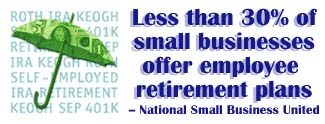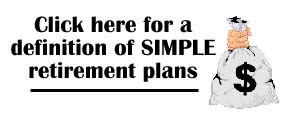|
Retirement plans for small biz
|
 |
April 19, 1999: 10:14 a.m. ET
Retirement plans are valuable recruiting tools for small employers
|
NEW YORK (CNNfn) - Flexible hours. Profit potential. The satisfaction of controlling your own career. There's no doubt about it, self-employment has its rewards.
When it comes to retirement savings, however, experts say too few small-business owners plan ahead. Fewer still take advantage of the low-cost investment tools that were designed for their benefit, including the simplified employee retirement pension (SEP).
"Not enough are saving," said Todd McCracken, president of National Small Business United. "They are afraid of the costs [associated with setting up and administering a plan.] For many, it's also a financial issue. They are not at the point yet where they have the money to set aside [for future living expenses]."

McCracken noted that the percentage of small businesses offering pension plans is slowly rising, possibly due to the increasingly competitive workforce and the new investment vehicles that have been introduced.
But the numbers are still surprisingly low. NSBU surveys reveal that 28 percent of small business owners (including the self-employed) have retirement plans in place.
SEPs
If you are among the vast majority without a plan, you might want to consider setting up a simplified employee pension, or SEP, one of the oldest and easiest-to-administer retirement tools around.
In most cases, the plans enable you to contribute more to your retirement account than traditional Individual Retirement Accounts [IRAs] would allow, on a tax-deductible and tax-deferred basis.
SEPs have been around since 1978, when Congress passed the Revenue Act, which made it easier (and more affordable) for small-business owners to set up and administer retirement plans for themselves and their employees.
"The benefit primarily is that they are easy to set up," McCracken said. "They are also much lower-cost [than the 401(k) plans offered by many larger corporations]."
As a small-business owner, you need only fill out a form that sets up an individual retirement account (IRA) for yourself (and your employees if you have any). Then simply mail it in, and sit back.
"It gives the small employers an opportunity to provide a retirement vehicle for employees without them having to deal with the administrative burden because essentially all they have to do is fill out the form for each employee and the bank takes over as the custodial trustee," said Gloria Della, a Labor Department spokeswoman.
The employee decides which mutual fund he or she wants the plan invested in. And the bank or financial institution that issues the SEP takes over as its trustee.
Small-business owners can contribute as little or as much as they want to their own and their employees' IRA each year. Any contributions made are tax deductible. And the IRA grows tax deferred (so there are no complicated tax-filing requirements).
As an investment tool, SEPs operate roughly the same as 401(k) retirement plans, commonly offered by larger employers. The average SEP return is 7 percent to 8 percent a year.
The 401(k), however, can cost small employers several thousand dollars a year. The SEP is virtually cost free.
"These plans are not truly employer sponsored," McCracken said. "Once the employee writes the check, the employer really has no more role. From that point on it looks to the employee like an IRA."
It also acts as an IRA, with the same penalties for early withdrawal. You'll be assessed a 10 percent excise tax on amounts withdrawn from your SEP before age 59-1/2, (except in the form of an annuity, or in the event of death or disability of the covered worker). For the record, you cannot take loans from your SEP either.
The difference is, you are not limited to a $2,000 annual investment, as you are with a traditional IRA.
There are, however, a few restrictions.
The Employee Benefit Research Institute reports that of the limited number of small employers aware of SEPs, interest in the plans may be tempered by concern about the nondiscrimination requirements.
Under these pension plans, the employer is required to make contributions on behalf of employees who may not remain long with the employer. The employer might rather use those funds to reward loyalty and quality to longer-term employees.
Some employers, too, may be miffed by the fact that employees who participate in SEPs are 100 percent vested from the get-go. Such an arrangement does little to encourage workers to remain with the company.
Deductible contributions (in your own plan and that of your employees) cannot exceed 15 percent of your total compensation.
Choices
As a member of the self-employed community, however, you aren't limited to the SEP as an investment vehicle.
One of the newest options available is the SIMPLE plan - or the Savings Incentive Match Plan for Employees of Small Employers - set up in 1997 for businesses with 100 or fewer employees.
The plan, recommended as a start-up savings tool for small businesses that previously offered nothing, works through employee salary reductions and matching contributions (similar to those found in a 401(k) plan).
Under the plan, eligible workers can contribute up to $6,000 a year in payroll deductions and the employer offers matching contributions, generally up to 3 percent of their total pay.

As with a SEP, all contributions made under a SIMPLE plan are 100 percent vested -- meaning all contributions immediately belong to the employee.
401(k)
Not to be forgotten is the 401(k), the most popular investment tool in the small and larger business community. The Labor Department reports an estimated 25 million U.S. workers are enrolled in 401(k) plans that hold total assets of about $1 trillion.
Under the plans, employees contribute a percentage of their wages on a tax-deferred basis through payroll deductions. Employers can also contribute by matching employee contributions, or a percentage of such contributions.
Lastly, there's the Payroll Deduction IRA, the easiest (and cheapest) of the small-business retirement plans. Under this plan, employees make the only contributions to their IRA through payroll deductions. It's up to them to decide whether to put money away and they are limited to the standard IRA cap, $2,000.
(Click here for a Labor Department breakdown of the most common small business retirement plans)
You can also call the Labor Department's Pension and Welfare Benefits Administration hotline for pension-related publications: 1-800-998-7542.
Keogh
The Keogh plan is the only retirement tool designed specifically for the self-employed. It can, like the SEP, be used by both self-employed and small-business owners.
The 1962 Congressional Act which established the plans allowed unincorporated small-business owners, farmers, and those in professional practice to establish and participate in tax-qualified plans similar to those of corporate employers. The self-employed, according to the Employee Benefit Research Institute, may be either sole proprietors or members of a partnership.
The main difference between the two plans, according to Della of the Labor Department, is that the Keogh allows for a higher level of contribution than does the SEP.
"The Keogh is really as close you can get [in structure] to a larger corporate plan," she said. "It's just that it tends to be used for small businesses and the self-employed."
Della noted that retirement plans are an important savings tool for the self-employed, at least for those who hope to maintain their standard of living in their Golden Years. They also are becoming important recruiting vehicles for small employers (those with a maximum of 100 employees), who compete with the benefit packages of larger corporations.
But she stressed the importance of reviewing each of these plans on your own, factoring in all the variables that affect your business. Hiring a financial advisor can help you make the right decision.
"The point [is] that each one of these plans should be assessed from the perspective of the employer," Della said. "They have to think about how much they can afford, what is their willingness to make retirement plans available to their employees. These factors, and others, interact to determine which one is best." 
--by staff writer Shelly K. Schwartz
|
|
|
|
|
 |

|

